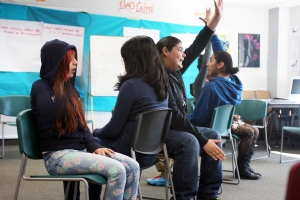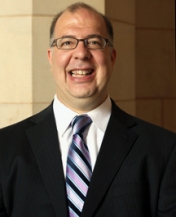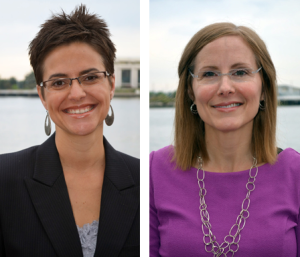
Genevieve Martínez García
While teen births rates are rapidly dropping, the disparity between Latino girls and their White and Black peers is still noticeable. This disparity has led researchers and program administrators alike to ask themselves…how much of Latino teen pregnancies are intended? It is not an unusual question since the number of unintended pregnancies is quite high. It is estimated that in 31 out of 50 states, more than half of pregnancies are unintended, about half of which resulted in actual births (Kost, 2013).
Pregnancy intentions have been measured in multiple ways, assessing pregnancy intentions during conception, level of happiness with pregnancy at birth, or number of years between actual and planned conception. These measurements have resulted in multiple variables: unintended, unwanted, or mistimed pregnancies. However, these measurements are exclusively asked to pregnant or parenting mothers. My curiosity was to find out if girls and boys have a secrete desire to get pregnant, and what are the environmental conditions that may lead a teen to think a pregnancy can be a good thing in their lives.
Through extensive formative research (interviews, focus-groups and key stakeholders’ consultation), I developed a scale to assess pregnancy intentions among Latino youth in one Maryland county. The “Pregnancy Wantedness Scale” (PWS) asked respondents to rate on a 5-point Likert scale their level of agreement on 20 statements that described positive and negative consequences of an immediate pregnancy. High scores on the PWS indicate higher levels of positive attitudes towards and pregnancy. These attitudinal items stated for example “Having a baby right now would make me happy” or “If I have a baby right now my partner would stay with me.” We built a linear regression model to explore the impact socio-demographic and cultural attributes have on the level on pregnancy wantedness. We included indicators of income, family education, household composition, religion, acculturation, age, and contraception use. I also wanted to isolate the results by gender and level of sexual experience, so we split our sample of 794 Latino youth ages 14-19 into four groups. (For a full description of the methods, data tables, strengths, and limitations please see the full text article here)[1].
The sample was slightly more male (57%) with a mean age of 16.9 years. Forty-two percent (42%) were born outside the U.S., and 43% immigrated as children under 13. Many of the youth immigrated from El Salvador, Honduras, or Guatemala (36%) and most (70%) lived with their mother, or with mother and father. Their mothers’ level of education was pretty low. About half (50.6%) had less than high school degree, and only 14.7% had some college degree which is consistent with education levels of Central American immigrants nationwide (Pew Hispanic, 2014). Half of the respondents considered themselves Catholic (50.5%) and reported that religion was very important or important (38.1%) in influencing their decisions about sexuality and contraception.
Most of the sample (60.8%) reported having had vaginal sex at least once in their lifetime. Of these, 43% of the males first had sex by age 13 and 20% of the females at 14 years. Although 68.5% and 52.7% of sexually active male and female respondents respectively used a condom during their last sexual intercourse, 23.8% reported using no method or using withdrawal. Fourteen percent of sexually active males and 25.5% of sexually active females had experienced a pregnancy.
We found that teens in general did not intend to get pregnant. However, their overall score on the PWS scale hovered just below the midpoint. This means that their intentions to NOT get pregnant were not very strong either. Surprisingly this ambivalence is precisely what places them at risk of a pregnancy. Previous studies that examined ambivalence found that female youth who are ambivalent towards becoming pregnant are less likely to use contraception (Stevens-Simon, Sheeder Beach, & Harter, 2005; Kavanaugh & Schwarz, 2009; Frost, Singh, & Finer, 2007), more likely to have an abortion (Rosengard, Phipps, Adler, & Ellen, 2004), and more likely to get pregnant (Zabin, Astone, & Emerson 1993) than female youth with negative or even positive attitudes about pregnancy.
How did the four subsamples compare to each other in terms of their levels of pregnancy wantedness? The sexually experienced sample had a significantly higher level of pregnancy wantedness PWS mean of 50.5 compared to 47.1 of the abstinent sample. Females had significantly lower scores than males (mean= 46.5 versus 48.8 respectively), and abstinent females had lower scores than their sexually active peers (44.1 versus 48.8 respectively). Differences in pregnancy wantedness levels between sexually experienced and abstinent males were not significant.
So what are the factors that may cause this ambivalence? We discovered that for all four groups, living with their mother, and living with their mother AND father was a protective factor that decreased their pregnancy wantedness. However, each group had different factors that impacted their attitudes towards a teen pregnancy. For those with no sexual experience, their mother’s education (having at least completed high school completion or having some college education) decreased their PWS scores. Males were influenced by their religious views. Those who considered religion important in their sexual behavior decisions had higher pregnant wantedness scores, suggesting that traditional religious views encourage familism. One interesting finding is the effect of acculturation in females’ attitudes towards a pregnancy. For abstinent females, greater levels of language acculturation—meaning they spoke more English than Spanish—translated into lower PWS score. For sexually experienced females having been born outside the U.S. decreased their pregnancy wantedness. Another surprising finding is that only hormonal contraception use at last sexual intercourse was found significant in decreasing pregnancy wantedness among sexually active females, but condom use was not significant in any group.
How do social determinants affect pregnancy wantedness?
The table below lists the social determinants found significant in reducing (-) or increasing (+) the PWS score, or pregnancy wantedness among Latino teens.
 What’s the take home message?
What’s the take home message?
We found that Latino youth do not want to get pregnant in most cases. However, their ambivalent attitudes towards a pregnancy might place them at risk by not actively seeking effective ways to prevent a pregnancy. As sexual health educators, we need to shift our lens and think beyond the classroom, the contraception, and the curriculum we teach. Where Latino youth live, learn, and play matters! And this is evidenced by the familial, social, and cultural environment that helps shape their views towards a pregnancy and towards actively seeking pregnancy protection. This study suggests that the family environment (who lives with the youth and their level of education), their beliefs (religion), their acculturation level (language use and place of birth), and use of hormonal contraception play an important role in youth’s sexual and reproductive health decisions. Condom use, the desired behavioral outcome of evidence-based teen pregnancy prevention programs, appears irrelevant to pregnancy desire. It would be interesting to explore more in-depth the acculturation dynamics that impact sexually abstinent girls differently and the religious views males hold. Teen pregnancy prevention efforts must expand the scope of their targeted outcomes, and consider social determinants of health from social, economic and cultural contexts in which Latino youth live, work, and play to promote healthy sexuality for all.
[1] Martínez-García, G. Carter-Pokras, O., Atkinson, N., Portnoy, B. & Lee, S. (2014). Do Latino youth really want to get pregnant?: Assessing pregnancy wantedness. American Journal of Sexuality Education, 9:3, 329-346. http://dx.doi.org/10.1080/15546128.2014.944735
References
Kost, K., Henshaw, S., & Carlin, L. (2010). US teenage pregnancies, births and abortions: National and state trends and trends by race and ethnicity.
Pew Hispanic (2014). 2011 Hispanic Origin Profiles. Retrieved on September 20, 2014 from http://www.pewhispanic.org/.
Stevens-Simon, C., Sheeder, J., Beach, R., & Harter, S. (2005). Adolescent
pregnancy: do expectations affect intentions?. Journal of Adolescent Health,37(3), 243-e15.
Kavanaugh, M. L., & Schwarz, E. B. (2009). Prospective Assessment of Pregnancy Intentions Using a Single‐Versus a Multi‐Item Measure.
Perspectives on sexual and reproductive health, 41(4), 238-243.
Frost, J. J., & Darroch, J. E. (2008). Factors associated with contraceptive choice and inconsistent method use, United States, 2004. Perspectives on sexual and reproductive health, 40(2), 94-104.
Rosengard, C., Phipps, M. G., Adler, N. E., & Ellen, J. M. (2004).
Adolescent pregnancy intentions and pregnancy outcomes: A longitudinal examination.Journal of Adolescent Health, 35(6), 453-461.
Zabin, L. S., Astone, N. M., & Emerson, M. R. (1993). Do adolescents want babies? The relationship between attitudes and behavior. Journal of Research on Adolescence, 3(1), 67-86.













You must be logged in to post a comment.